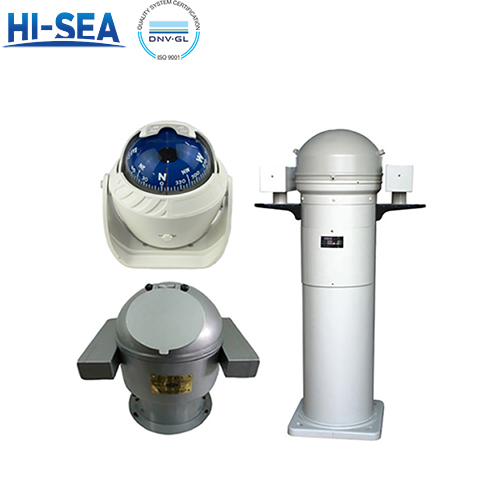
Marine Compass
Overview
General functions of a typical marine compass
Directional Reference: The primary function of a marine compass is to provide a reliable reference for determining the vessel's heading or direction relative to magnetic north.
Course Keeping: The compass helps the helmsman or navigator maintain a desired course by providing a constant reference point for steering.
Navigation: The compass is an essential tool for basic navigation, especially in conjunction with charts. It helps in plotting courses, estimating distances, and navigating along specific bearings.
Backup Navigation: In modern vessels equipped with electronic navigation systems, a marine compass serves as a reliable backup in case of electronic failures or power outages.
Safety: The compass plays a crucial role in ensuring the safety of the vessel and its occupants by helping to avoid navigational hazards and maintain a clear sense of direction.
Calibration and Compensation: Some marine compasses have features for calibration and compensation to account for any deviation caused by the vessel's magnetic influences. This ensures the accuracy of the compass readings.
Nighttime Navigation: Many marine compasses are equipped with illumination to facilitate navigation during nighttime or low-light conditions.
The standard & authentication: GB/T 14108-2011, IEC, ISO & IMO; approved by CCS
Main types
Magnetic compass: Table Model Marine Compass, Vertical Magnetic Compass, Projection Magnetic Compass, Reflector Magnetic Compass, Brass Magnetic Compass, Plastic Magnetic Compass, Boat Compass
Gyro compass
Maintenance and notes for compass operation
To maintain good conditions of the compass, it is essential to check periodically on the sensitivity of the compass, semi-periodically on bubbles and on the looseness of the screws on the legs.
Always keep clean: should always keep the moving frictional parts such ad compass pivot, gimbal ring, shock absorption systems etc lubricated.
In order to avoid reduction in magnetism due to high temperature or shocks, a standard compass should not be covered by compass dome when not in use. Add canvas cover. No knocking on the compass to avoid shocking the compass.
Maintain directional accuracy and prevent deviational changes of the compass: after adjusting the compass, the adjusting device should not be removed. Any iron objects should be avoided to bring into the bridge in order not to affect the accuracy of the compass. Should observe the remaining deviation, after a vessel receives shocks from running aground, collides, or loads or unloads iron or magnetic cargoes.
The accessories of marine compass
Mounting Brackets: These are used to securely attach the compass to the boat. Different types of boats may require different mounting options, such as flush mount, bracket mount, or binnacle mount.
Binnacles: A binnacle is a housing or protective cover for the compass. It shields the compass from the elements, including rain and direct sunlight, to ensure accurate readings.
Compensators: Marine compasses often come with compensators to correct for deviations caused by the boat's magnetic fields or other influences. These can include adjustable magnets or other mechanisms to fine-tune the compass readings.
Illumination: Many marine compasses have built-in illumination to ensure visibility during low-light conditions or at night. This can be essential for safe navigation.
Deviation Card: A deviation card is a table that provides information on the compass errors at various headings. It helps the navigator correct for these errors when plotting a course.
Clinometer: Some marine compasses include a clinometer, which indicates the angle of heel (tilt) of the boat. This information is crucial for sailors to maintain stability.
Marine sextant: It is a kind of reflection type angular measuring optical instrument, chiefly used for measuring the altitude of celestial bodies to obtain a position in navigation.
Three-arm graduation instrument: the three-arm graduation instrument cooperates with a sextant to measure the ship is position by either threepoint-two-angle method or angle-between-objective-plus-bearings method.
Bypass pipe: This is a dedicated for reflecting the 180 reflection magnetic compass on the tube, the product size can be customized according to customer’s demand to quality and reliable performance, reasonable structure, beautiful appearance.





